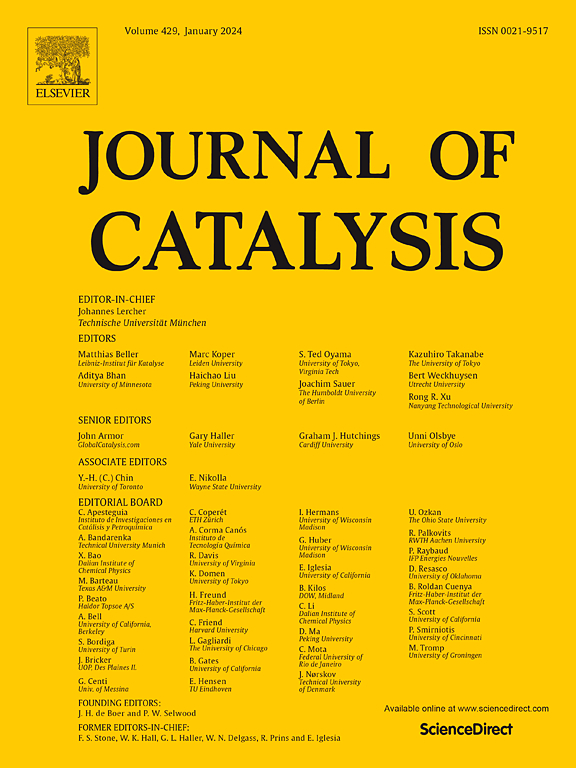锰促进的Ni/Al2O3催化剂的有效CO2甲烷化
IF 6.5
1区 化学
Q2 CHEMISTRY, PHYSICAL
引用次数: 0
摘要
二氧化碳加氢制甲烷是解决日益严峻的全球环境和能源挑战的可行方案。镍基催化剂对二氧化碳甲烷化反应效率高、成本低。在此基础上,我们合成了锰促进CO2甲烷化的Ni/Al2O3催化剂,并阐明了锰的关键作用。Mn掺杂后,NiMn/Al2O3催化剂的NiO分散性得到改善。随后,H2还原和CO2甲烷化处理导致NiO和MnO2还原为Ni和MnO,并将Ni2+掺入MnO晶格,形成NiMnOx并产生大量Ni-NiMnOx界面。NiMnOx丰富的氧空位可以增强CO2的活化。此外,界面上的氧空位也促进了Ni和MnO之间的电子转移,导致电子贫乏的Ni纳米颗粒,从而显著促进了*CO甲烷化。最终,电子贫乏的Ni纳米粒子和Ni- nimnox界面上丰富的氧空位共同促进了CO2的甲烷化。本文章由计算机程序翻译,如有差异,请以英文原文为准。

Manganese-promoted Ni/Al2O3 catalysts for effective CO2 methanation
Hydrogenation of CO2 to methane is a feasible solution to the growing global environmental and energy challenges. Nickel-based catalysts are efficient and cost effective for CO2 methanation. Hernin, we synthesized Mn-promoted Ni/Al2O3 catalysts with facilitated CO2 methanation and elucidated the crucial role of Mn. After Mn doping, NiMn/Al2O3 catalysts showed improved NiO dispersion. Subsequently, H2 reduction and CO2 methanation treatments resulted in reduction of NiO and MnO2 into Ni and MnO, and incorporation of Ni2+ into MnO lattice, forming NiMnOx and creating numerous Ni-NiMnOx interfaces. The abundant oxygen vacancies from NiMnOx could enhance CO2 activation. Moreover, oxygen vacancies at the interface also promote electron transfer from Ni and MnO, leading to electron-poor Ni nanoparticles and thus significantly promoting the *CO methanation. Ultimately, the electron-poor Ni nanoparticles and abundant oxygen vacancies at the Ni-NiMnOx interface jointly facilitate CO2 methanation.
求助全文
通过发布文献求助,成功后即可免费获取论文全文。
去求助
来源期刊

Journal of Catalysis
工程技术-工程:化工
CiteScore
12.30
自引率
5.50%
发文量
447
审稿时长
31 days
期刊介绍:
The Journal of Catalysis publishes scholarly articles on both heterogeneous and homogeneous catalysis, covering a wide range of chemical transformations. These include various types of catalysis, such as those mediated by photons, plasmons, and electrons. The focus of the studies is to understand the relationship between catalytic function and the underlying chemical properties of surfaces and metal complexes.
The articles in the journal offer innovative concepts and explore the synthesis and kinetics of inorganic solids and homogeneous complexes. Furthermore, they discuss spectroscopic techniques for characterizing catalysts, investigate the interaction of probes and reacting species with catalysts, and employ theoretical methods.
The research presented in the journal should have direct relevance to the field of catalytic processes, addressing either fundamental aspects or applications of catalysis.
 求助内容:
求助内容: 应助结果提醒方式:
应助结果提醒方式:


